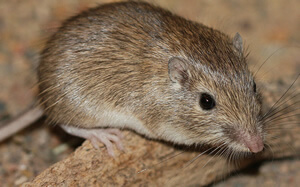

Students learn how the same trait can evolve independently in different populations and how analysis at multiple levels from the molecular to the ecological contributes to a better understanding of evolution by natural selection. Multiple-choice questions in the video and analysis and discussion questions in the Student Handout guide students to a better understanding of mutation, environment, and natural selection. It's amazing to think that one nucleotide changed the whole course of the rock pocket mouse's future.Students view a brief video that presents research findings concerning the roles of mutation and natural selection in the evolution of fur color in rock pocket mice. The species would probably not even be able to continue on because the light colored mice would be eaten by prey. If what the study suggests is true, imagine if the mutation of the MC1R never occurred, and all the mice stayed light colored. This was an awesome article to read up on because it really shows how LITERALLY one nucleotide could potentially change the whole future of a species. But does this mean that all the mice in light-colored sand area have only recessive genotypes? In the future, researches hope to answer two questions that have arisen: 1.) Has the color change in mice been driven by a single nucleotide, and the other 3 have just come along for the ride? *or perhaps* 2.) It takes multiple nucleotide variants to produce the colored phenotype of the rock pocket mouse? Since selection is driving these phenotypic changes, this makes perfect sense. In the dark colored sand, approximately 9% of mice are born with a light coat, and 89% are born with a dark coat. These studies leave scientist to even more questions. The change of just 4 nucleotides seem to have caused the drastic shift from a light brown, to a dark almost black coat color.

All mice with that were homozygous dominant, or heterozygous dominant showed a dark coat. From the information gathered, it was concluded that the dark colored coat was more dominant that the light colored coat, which is consistent with the observations seen on laboratory mice. The MC1R plays a crucial role in normal pigmentation. In the lava dwelling mice, four mutations were found in the MC1R gene. Instead, researchers studied the current mice comparing them with lab mice and came up with some interesting results. This made crossing them with each other almost impossible. Due to the pocket mice wild nature, they are hard to breed in captivity. Luckily for the researchers in the rock pocket mice, many studies have been done on the pigmentation of laboratory mice, which lended a hand in the study done on the rock pocket mice.

However, in order to do this, the biologist working on the project must have a solid understanding of genetic information of the animal they are working on, AND then compare it to how the environment has newly changed that genetic information. Researchers have worked diligently in recent years to try to find correlation between ecological and environmental changes, and changes in animal genetics. Now, these mice have different phenotypes for coat color, but the story becomes more interesting when we start to analyze the genetic information about the mice coat colors. Natural selection has driven these animals to evolve based on their environment being more brown, or more black.

Their coat colors clearly emphasize the importance of a tactic animals use crypsis, which is essentially camouflage. Having this knowledge, it makes sense that the mice living in the brown sand environment have a brown coat, and the mice living in the dark lava colored sand have a dark black coat. Natural selection is a process in which organisms most fit for their environment survive and produce offspring. Mammalian and avian predators have perfectly modeled out what is known as natural selection. From an biological standpoint it might be rather easy to see why the two coat colors exist. For the pocket mice, this was a huge ecological change, which in turn resulted in a rather fascinating genetic phenomenon.Ĭurrently, two forms of pocket mice exist. About 1.7 million years ago, volcanic eruptions spewed lava into the desert causing portions of the land to be fractured with dark black colors. Light brown sand covers most of the desert, and has for quite some time. Throughout the the southwest United States and Mexico, a tiny rodent, called the Rock Pocket Mouse, lives in the rocky deserts.


 0 kommentar(er)
0 kommentar(er)
